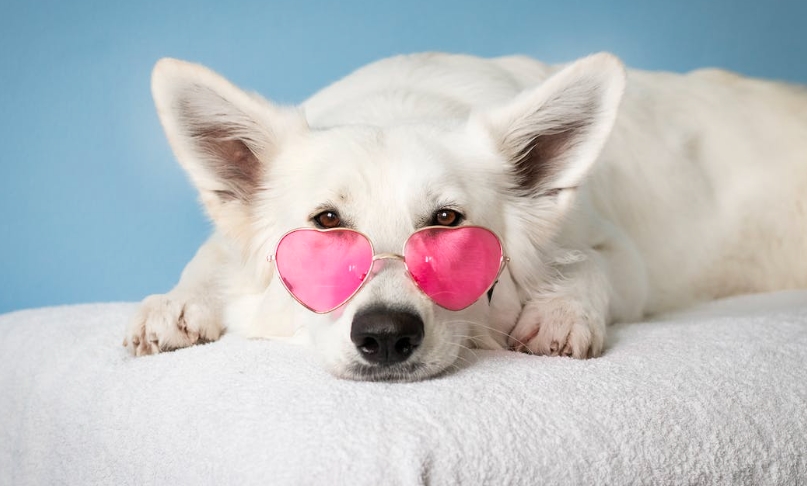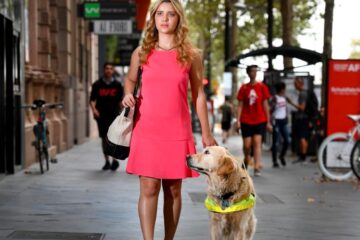Having a dog can be one of the most rewarding experiences for pet owners. However, it is important to understand that proper training and behavior techniques are essential for a successful dog-owner relationship. Good Dog! Training and Behavioral Techniques for Your Canine Companion is a comprehensive guide to help pet owners learn the basics of proper training and behavior techniques for their canine companion.
The book covers a wide range of topics related to dog training and behavior, such as understanding your dog’s behavior, the importance of socialization, basic obedience training, and how to effectively address problem behaviors. This book provides pet owners with the knowledge and tools they need to establish a respectful and loving relationship with their dogs. The book explains the benefits of proper training and behavior, such as improved obedience, socialization, and overall well-being. Additionally, pet owners can learn how to create a safe and secure environment for their dog and how to effectively manage problem behaviors.
The book is written in an easy to understand format and is designed to provide pet owners with the information they need to effectively train and care for their canine companions. Good Dog! Training and Behavioral Techniques for Your Canine Companion is the perfect guide for pet owners looking to improve their training and behavior techniques for their dogs. With the help of this book, pet owners can ensure that their dog is happy and healthy, while also ensuring that their relationship with their canine companion is positive and respectful.

Positive Reinforcement Training:
Positive reinforcement training is a great way to train your dog in a safe and effective manner. It is a type of training that focuses on rewarding good behavior with treats, verbal praise, and other forms of positive reinforcement. Not only does positive reinforcement training help to strengthen the bond between you and your dog, it also helps to create a healthier and happier relationship.
The Benefits of Positive Reinforcement Training
• It creates a strong bond between you and your dog.
• It encourages good behavior by rewarding it with treats, verbal praise, and other forms of positive reinforcement.
• It helps to create an atmosphere of trust and safety.
• It helps to reduce unwanted behaviors and increase desirable behaviors.
• It can be used to train puppies as well as older dogs.
• It can be used to teach basic obedience commands such as sit, stay, and come.
• It can be used to teach more advanced behaviors such as agility, tricks, and more.
Types of Positive Reinforcement Training
• Clicker Training: Clicker training is a type of positive reinforcement training that uses a clicker sound to mark desired behaviors. The clicker is used to mark the desired behavior at the exact moment it occurs. The clicker sound is then followed by a reward, such as a treat or verbal praise.
• Treat Training: Treat training is a type of positive reinforcement training that uses treats to reward desired behaviors. The treat is used to mark the desired behavior at the exact moment it occurs. The treat is then followed by verbal praise or a reward of some kind.
How to Use Positive Reinforcement Training
• Choose a reward that your dog enjoys. This could be a treat, verbal praise, or a toy.
• Begin by teaching the desired behavior. When your dog performs the behavior correctly, mark the behavior with a clicker sound (if using clicker training) or a treat (if using treat training).
• Give the reward immediately following the clicker sound or treat.
• Repeat this process until the behavior is learned.
• Once the behavior is learned, you can begin to phase out the rewards, eventually only rewarding the behavior occasionally.
• Make sure to give your dog plenty of breaks during the training sessions.
• Be consistent in your training and use positive reinforcement techniques to help your dog learn.
Crate Training:
Crate training is an important part of housebreaking and managing behavior for dogs. It involves teaching the dog to view the crate as a safe and comfortable place to stay. Crate training has many benefits, ranging from providing security and comfort to helping to manage bad behaviors. It is important to choose the right size and type of crate for your dog and to introduce them to it in the right way. This article will explain the benefits of crate training for dogs, how to choose the right crate for your dog, and provide step-by-step instructions on how to crate train your dog properly.
Benefits of Crate Training:
• It helps with housebreaking and potty training as dogs are naturally clean and do not want to soil their sleeping area.
• It can provide a sense of security for your dog and a place to retreat when things become too overwhelming.
• It can help to manage bad behaviors, such as barking, chewing, and digging.
• It can help to keep your dog safe when you are not home.
Choosing the Right Crate:
• Size – The crate should be big enough for the dog to stand up and turn around, but not so big that they can use one end as a bathroom.
• Material – Most crates are made of either plastic or wire. Plastic crates are best for younger puppies, while wire crates are better for older dogs.
• Location – The crate should be placed in a quiet area of the house, away from drafts and direct sunlight.
Introducing Your Dog to the Crate:
• Place the crate in an area of the house where the family spends time, and make sure it is comfortable and inviting.
• Put a blanket or pillow inside the crate and some of the dog’s favorite toys.
• Let the dog explore and get used to the crate on their own. Praise them when they enter the crate, but do not force them.
• Offer treats when the dog enters the crate, to associate it with positive reinforcement.
Crate Training Your Dog:
• Start with short periods of time in the crate. Put the dog in the crate with a treat and a toy and leave them for a few minutes.
• Increase the amount of time gradually. Do not leave them in the crate for more than a few hours at a time.
• Let the dog out of the crate when they are quiet and calm. Do not let them out if they are barking or whining.
• Once the dog is used to being in the crate, you can start to leave them alone for longer periods of time.
Leash Training:
Leash Training for Dogs
Leash training for dogs is an important part of having a well-behaved pet. Not only is it important for safety reasons, but it also helps with obedience and can even help with keeping your dog calm. When done properly, leash training can be a great way to bond with your pet and help them understand basic commands.
Choosing the Right Leash and Collar
When it comes to choosing the right leash and collar for your pet, there are a few things to consider. The size and weight of your pet will help determine the best option. A lightweight leash and collar are recommended for smaller dogs, while a stronger, heavier leash and collar are better for larger breeds. It’s also important to note that a leash and collar should be put on correctly and adjusted to fit snugly.
Step-by-Step Instructions on How to Leash Train Your Dog
Leash training your dog starts with the basics. Here are some simple steps to help you get started:
• Start by introducing your pet to the leash and collar. Let them explore their new accessories and get comfortable with them.
• Once your pet is comfortable, it’s time to start attaching the leash and collar. Make sure they are securely attached and adjusted to fit properly.
• Once your pet is used to the leash and collar, it’s time to start walking. Begin slowly and keep your pet close by you.
• As you walk, give simple commands like “sit” and “stay” to help your pet understand the basics.
• Gradually increase the distance and speed as your pet gets more comfortable.
• Make sure to reward your pet with treats or praise when they follow instructions.
• As your pet is getting the hang of leash training, you can add in more complicated commands like “come” and “leave it”.
• If your pet becomes distracted or unruly, take a break and start again when they are calm.
Benefits of Leash Training
• Improved safety for your pet and others
• Helps with basic obedience
• Strengthens the bond between you and your pet
• Teaches your pet to follow commands
• Helps keep your pet calm and focused
Tips for Leash Training
• Be consistent with commands and rewards
• Make sure you are using the right size and weight of leash and collar
• Practice in a quiet, distraction-free area
• Don’t be afraid to take a break if your pet gets too distracted or overwhelmed
• Praise your pet often and reward them with treats when they follow instructions
• Keep sessions short and sweet
• Be patient with your pet and don’t expect too much too soon
Leash training your pet is a great way to strengthen the bond between you and your pet and ensure their safety. With patience and consistency, you can easily teach your pet the basics of leash training.
Socialization:
Socialization for dogs is an important process for a dog’s development and overall well-being. It helps them to learn how to interact with other dogs and people, as well as to become accustomed to different environments and situations. Proper socialization can also help prevent behavior problems such as aggression, anxiety, and fear. In this article, we will explore the importance of socializing your dog, how to socialize them, and provide step-by-step instructions on how to do so.
Importance of Socialization:
Socializing your dog is a crucial part of their development. It helps them to become accustomed to different people, animals, and environments. As a result, they are less likely to exhibit fear or aggression when in new or unfamiliar situations. In addition, socialization helps to build trust and strengthens the bond between the dog and their owner. It also teaches them good manners and helps them to understand their boundaries.
Benefits of Socialization:
• Helps to prevent fear, aggression, and anxiety
• Builds trust and strengthens bond between the dog and their owner
• Teaches them good manners and respect
• Helps them to become accustomed to different people, animals, and environments
• Increases their confidence in new situations
Socializing Your Dog:
Socializing your dog can be a daunting task for some, but it is important to remember that it is a process that takes time and patience. Here are some tips to help you get started:
• Start small – begin by introducing your dog to a few people or other dogs and gradually increase the number of social contacts.
• Make sure your dog is comfortable – give them treats and praise when they are in a new situation.
• Take it slow – introduce your dog to new people or animals gradually.
• Be patient – some dogs may take longer than others to become comfortable in new situations.
• Socialize in different environments – take your dog to different places, such as parks, beaches, and pet stores.
• Reward good behavior – give your dog treats and praise when they behave well in new situations.
Step-by-Step Instructions:
1. Start by introducing your dog to a few people or other animals. Make sure they are comfortable and reward them with treats and praise.
2. Gradually increase the number of people or animals they are exposed to. Take it slow and be patient – some dogs may take longer than others to become comfortable.
3. Take your dog to different environments, such as parks, beaches, and pet stores. Make sure to reward good behavior with treats and praise.
4. If your dog is displaying fear or aggression in a new situation, take a step back and reassess the situation. Take it slow and don’t force them into a situation they are not comfortable with.
5. Be consistent with your training and socialization. Spend time with your dog and continue to expose them to new people, animals, and environments.
6. Finally, remember to have fun! Socializing your dog should be an enjoyable experience for both you and your dog.
Behavioral Issues:
Dogs are beloved and cherished members of many households, but they can sometimes exhibit behaviors that can be difficult to manage. Common behavioral issues that dogs may exhibit include separation anxiety, aggression, and excessive barking. These issues can be caused by many different factors, including environmental changes, fear, and neglect. It is important to understand the causes of these issues and how to prevent and manage them.
Separation Anxiety:
Separation anxiety is a common behavioral issue in dogs that is often caused by changes in their environment or routine. It can be difficult to detect and can lead to destructive behavior, such as chewing, digging, and barking. To prevent separation anxiety, it is important to provide your dog with a consistent routine and ample exercise. Additionally, providing them with a safe and comfortable place to go when you are not home can help to reduce their anxiety.
If your dog is exhibiting signs of separation anxiety, it is important to address the issue as soon as possible. You can begin by providing them with consistent routine and exercise as mentioned above. Additionally, it is important to provide them with positive reinforcement when they are displaying desired behaviors. You can also provide them with a safe space, such as a kennel or bed, and provide them with calming chews or toys when you need to leave the house.
Aggression:
Aggression is another common behavioral issue that can be caused by fear, neglect, or environmental changes. It is important to understand the signs of aggression and how to manage it. Signs of aggression can include growling, snapping, or biting. It is important to address any aggressive behavior as soon as possible.
To prevent aggression, it is important to provide your dog with consistent, positive reinforcement. Additionally, it is important to provide them with plenty of exercise and to socialize them with other dogs. If your dog is exhibiting signs of aggression, it is important to provide them with a safe, calm environment and to avoid punishing them. Instead, you should provide them with positive reinforcement when they are displaying desired behaviors.
Excessive Barking:
Excessive barking is another common behavioral issue that can be caused by boredom, fear, or attention-seeking behavior. To prevent excessive barking, it is important to provide your dog with plenty of exercise and mental stimulation. Additionally, it is important to provide them with consistent, positive reinforcement when they are displaying desired behaviors.
If your dog is exhibiting excessive barking, it is important to address the issue as soon as possible. You can begin by providing them with a consistent routine and ample exercise as mentioned above. Additionally, it is important to provide them with positive reinforcement when they are displaying desired behaviors and to provide them with calming chews or toys when necessary. Additionally, it is important to avoid punishing them for barking, as this can exacerbate the issue.

Dog Training Tools:
Training and behavioral techniques are an important part of helping your canine companion become the best they can be. There are many different training tools available to help you train your dog and address any behavioral issues they may have. These tools can include Dog Training Tools
Dog training tools can include clickers, treats, toys, and even remote training collars. Clickers can help you teach your dog behaviors, such as sit, stay, and come. Treats can be used as a reward
Dog training tools are essential for teaching a dog how to make the right decisions and perform desired behaviors. There are many types of dog training tools available, including clickers, treats, and training collars. It’s important to use the right tool for the right situation and to understand how to use it properly and safely.
Clickers
A clicker is a small device with a metal tongue that produces a loud clicking sound when pressed. Clickers are used to mark the exact moment a desired behavior is performed. This helps to reinforce the behavior and let the dog know it was the right decision. When used in combination with a reward, such as a treat, clickers can be a powerful training tool.
Treats
Treats are a great way to reward a dog for performing desired behaviors. It is important to use treats that are healthy and that the dog enjoys. Treats can be used to reward the dog for performing the desired behavior, as well as to motivate the dog to continue performing the behavior.
Training Collars
Training collars are used to control the dog’s behavior in certain situations. The most common type of training collar is a choke collar, which is used to give a gentle tug on the dog’s neck when it performs an undesired behavior. Other types of training collars include prong collars, shock collars, and vibrating collars. It is important to understand how to use these collars properly and safely.
Benefits of Dog Training Tools
• Helps to reinforce desired behaviors
• Allows the dog to learn more quickly
• Motivates the dog to perform the desired behavior
• Reduces the need for punishment
• Improves communication between the dog and the owner
Tips for Using Dog Training Tools
• Use the right tool for the right situation.
• Use positive reinforcement techniques to reward the dog for performing the desired behavior.
• Start with simple commands and gradually increase the difficulty.
• Never use negative reinforcement techniques such as punishment.
• Be consistent in your use of the tools.
• Be patient and have fun with your dog.
Conclusion
Overall, Good Dog! Training and Behavioral Techniques for Your Canine Companion is a great resource for all dog owners and trainers. It offers a comprehensive approach to training and behavior modification for dogs of all ages and breeds. The book covers a wide range of topics from basic obedience training to complex behavior modification techniques. It provides practical advice and step-by-step instructions on how to train your dog, making it a useful resource for both novice and experienced dog owners and trainers. The authors have included helpful tips and advice throughout, making it easy to understand and follow. The book is filled with helpful illustrations and photos, which make it easy to understand the techniques described in the book. The authors have also included case studies and stories of success to help motivate and encourage readers. All in all, this book is an invaluable resource for any dog owner or trainer and is sure to help you and your canine companion have a more rewarding and enjoyable relationship.
FAQs
1. What is the best way to train my dog?
The best way to train your dog is to use positive reinforcement techniques, such as clicker training, reward-based training, and shaping. Positive reinforcement techniques are the most effective and humane way to train your dog, as they reward desired behaviors and discourage unwanted behaviors.
2. How do I stop my dog from barking?
To stop your dog from barking, you should identify the triggers that cause the barking, such as an unfamiliar noise or sight. Once you have identified the triggers, you can use positive reinforcement techniques, such as rewarding your dog for being quiet, to reduce the barking. It is also important to ensure that your dog has enough mental and physical stimulation to prevent them from becoming bored and restless.
3. How do I stop my dog from jumping on people?
To stop your dog from jumping on people, you should use positive reinforcement techniques, such as rewarding your dog for sitting calmly when visitors arrive. It is also important to ensure that your dog has enough mental and physical stimulation to prevent them from becoming overly excited. Additionally, you should discourage any jumping behavior by redirecting your dog’s attention to a more appropriate behavior.
4. What is the best way to socialize my dog?
The best way to socialize your dog is to start when they are young and expose them to different people and animals in a positive and safe environment. You can also use positive reinforcement techniques, such as clicker training, reward-based training, and shaping, to help your dog become comfortable and confident around other people and animals.
5. How do I stop my dog from digging?
To stop your dog from digging, you should ensure that they have enough mental and physical stimulation. You can provide your dog with appropriate toys to keep them entertained and provide them with plenty of exercise. You can also use positive reinforcement techniques, such as rewarding your dog for appropriate behavior, to discourage unwanted digging behavior.
6. How do I stop my dog from chewing on furniture?
To stop your dog from chewing on furniture, you should provide them with appropriate chew toys and regularly replace them. Additionally, you should use positive reinforcement techniques, such as rewarding your dog for appropriate chewing behavior, to discourage unwanted chewing behavior.
7. How do I stop my dog from pulling on the leash?
To stop your dog from pulling on the leash, you should use positive reinforcement techniques, such as rewarding your dog for walking calmly beside you. Additionally, you should ensure that your dog is properly fitted with a harness and that they have plenty of mental and physical stimulation to prevent them from becoming bored and restless.
8. How do I stop my dog from begging for food?
To stop your dog from begging for food, you should ensure that they are not present when you are eating, and that they are not allowed access to any food that has been left out. Additionally, you should use positive reinforcement techniques, such as rewarding your dog for not begging, to discourage unwanted begging behavior.
9. How do I stop my dog from running away?
To stop your dog from running away, you should ensure that they are properly fitted with a harness and that they are kept on a leash when outside. Additionally, you should use positive reinforcement techniques, such as rewarding your dog for staying close to you, to discourage running away behavior.
10. What should I do if my dog is aggressive?
If your dog is exhibiting aggressive behavior, it is important to consult with a professional dog trainer or behaviorist to assess the situation and develop a behavior modification plan. It is also important to ensure that your dog has enough mental and physical stimulation to prevent them from becoming bored and restless, as this can often lead to aggressive behavior.


















